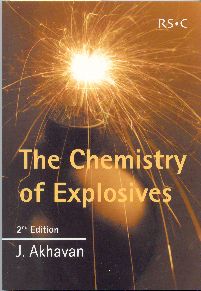

The Chemistry of Explosives, 2nd ed.Jacqueline AkhavanRoyal Society of Chemistry Paperbacks, 2004, 180 pages |
 hy read a book about explosives? Because every
living person has an obligation to learn about the things in this
world that can get them killed, whether it's tsunamis, explosives,
or members of Congress. Pretending these things don't exist won't
make you any safer. Chemists, in particular, need to know about
hazardous chemicals and dangerous substances.
hy read a book about explosives? Because every
living person has an obligation to learn about the things in this
world that can get them killed, whether it's tsunamis, explosives,
or members of Congress. Pretending these things don't exist won't
make you any safer. Chemists, in particular, need to know about
hazardous chemicals and dangerous substances.
Besides, every self-respecting chemist is fascinated by explosives. Many chemists were originally attracted to the field by seeing things get blown up during childhood. For professional chemists, on the other hand, it is imperative to know how explosives are made in order to avoid accidentally re-discovering their manufacturing technique---the hard way. For some reason, however, it is tough to find a book that covers the chemistry of these fascinating molecules.
This book describes the basic facts about important explosives and initiators used in industry and the military, and gives a brief introduction to rudimentary thermochemistry and kinetics of energetic materials, ending with a brief chapter on propellants. The thermochemistry and shock wave theory is presented at an elementary level, but the author's theory about "hot spots" gives the reader a good intuitive feel for how ignition occurs. Unlike most chemistry books, there are no references to the primary literature. A serious student should read C&TE instead of this book.
The author seems to have a serious comma deficiency, and the writing contains some grammatical rough spots. The writing is also somewhat repetitive, especially concerning nitroglycerine, which is described several times. A bigger problem is that the book only covers the commercially important explosives, and omits peroxides, NI3, and more exotic molecules. Because this tendency is also followed in many other, more complete textbooks, many chemists have the mistaken belief that only nitrates and azides are potential problems. This is a dangerous assumption, considering the instability of compounds such as ozonides, organometallic compounds and perchlorates, molecules that could easily turn up in the laboratory, make loud noises, and cause things to get broken.
These points are not really flaws in the book, but more of a wish list for topics that should be included in the third edition. In this edition, the author has written a simple and very concise introduction to the technology and chemistry of conventional explosives. If I were a safety director in a chemical plant, I would give a copy of this book to the entire staff. Except maybe that one guy with the funny accent over in the corner who just glares at everyone else.
